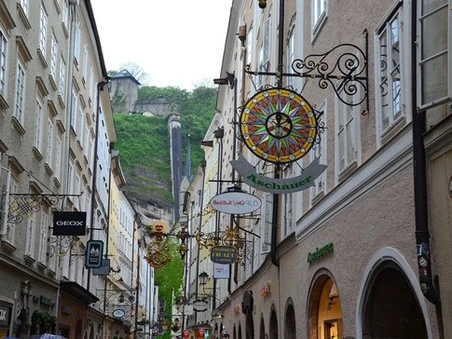3 Oldest Streets Of Salzburg Getreidegasse, Steingasse, Linzergasse
For a great shopping experience in Salzburg’s Old Town, visitGetreidegasse. It is a must-visit street because of its old-world charm, picturesque architecture, narrow alleyways and unique wrought iron signs. The street is famous for Mozart’s birthplace, as well as the variety of international designer shops and boutiques.
Background Information
Since the Roman era, when Salzburg was still known as “Juvavum,” the Getreidegasse has been a significant route. For many years, it served as the only important route between Salzburg and Bavaria. It is still debated that the word “getreide,” which means “cereal,” came from this because it was previously known as the Trabegasse and derived from the verb “traben,” which means “to trot.” It was formerly one of Salzburg’s most affluent areas, home to numerous physicians, breweries, wealthy businesspeople, and wealthy artisans.
Attractions
Take a walk around streets dotted with charming older homes, many of which feature lovely doors and windows that get smaller and smaller as you inspect the façade of th houses. Frequently houses have the names of previous owners, significant dates from their history, or even the eye of God painted on them. The district is characterized by a lot of through-houses. These structures serve as crossing points between streets and frequently contain art galleries and retail establishments. The Schatz House, which connects No. 3 Getreidegasse to University Square, is the most well-known of these because of the lovely little coffee house in the courtyard.
Steingasse
The Steingasse is an extremely historic street in the city of Salzburg. It served as a commercial route between Iuvavum (now Salzburg) and the southern regions of the Roman Empire in antiquity. There are some intriguing vistas along the roadway because the structures on the left side are immediately tied to the rocks of Kapuzinerberg Hill.
Background information
The Steingasse, which entered the city from the south, had a very important function to play in addition to the RiverSalzach, which was a crucial transportation route for salt, the “white gold of the mountains.” One of the most important north-south trade routes in medieval times, it was also the most trafficked path into the highlands and beyond Italy. Nevertheless, local shopkeepers and artisans also operated along this tiny city street. The trades that required the most water, such as pottery makers, dyers, and tanners, preferred to congregate here.
Today's Steingasse
A leisurely stroll along the Steingasse is a pleasant activity, especially in the early morning when the sun brilliantly lights the exteriors of the historic homes. These days, this street only has a few stores. The small Steingasse has been replaced as a main roadway by the Imbergstrasse. Nowadays, the homes along Steingasse are mostly used as residences.
Linzergasse
The Linzer Gasse is a well-known tourist street that runs along the right bank of the river through Salzburg’s historic quarter. This street begins at the “Platzl,” a tiny square next to the Staatsbrücke bridge, and extends as far as Schallmoos while running parallel to the Kapuzinerberg. Unique shops, upscale eateries, and historic hotels beckon travelers to pause along the road.
Background Information
The Linzer Gasse has been a major route on the opposite side of the Old Town since Roman times, and it used to be the most crucial route for passengers leaving Salzburg in the direction of Linz, Vienna, and the northern regions of the Habsburg Empire. The Linzer Gasse’s old merchants’ residences could subsequently be restored nearly entirely, despite the terrible city fire of 1818 showing little mercy to the homes built in the 14th and 15th centuries. Similar to the opulent and extremely international Getreidegasse, the Linzer Gasse has almost always placed a premium on traditional craftsmanship and artistic expression.
Highlights To Look For
An imposing medieval gate and staircase take us through the Stations of the Cross and up the Kapuzinerbergwhen leaving the Linzer Gasse. Be rewarded with unparalleled views of the entire Salzburg historical district on top of the hill. If you choose not to take this side trip up the Kapuzinerberg, it is strongly advised that you pay St. Sebastian’s Cemetery a visit. This lovely, hidden gem, which may be found in the high reaches of the Linzer Gasse, was originally built at Prince-Archbishop Wolf Dietrich’s request and is meant to resemble an Italian “Campo Santo.”

